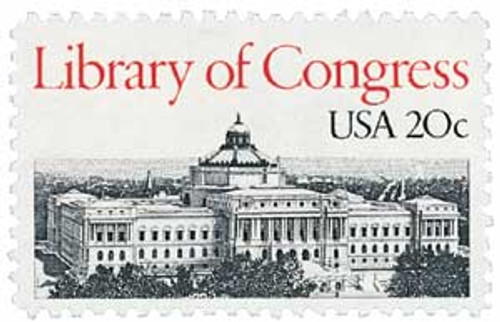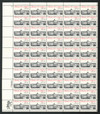
# 2004 - 1982 20c Library of Congress
U.S. #2004
1982 20¢ Library of Congress
- Issued three days before the 182nd anniversary of the founding of the Library of Congress
- Pictures the Thomas Jefferson Building, largest library building in the world at the time
- Issued during National Library Week
Stamp Category: Commemorative
Value: 20¢, first-class rate
First Day of Issue: April 21, 1982
First Day City: Washington, DC
Quantity Issued: 112,535,000
Printed by: Bureau of Engraving and Printing
Printing Method: Engraved
Format: Panes of 50 in sheets of200
Perforations: 11
Color: Red and black
Why the stamp was issued: To commemorate the 182nd anniversary of the Library of Congress as well as National Library Week.
About the stamp design: Bradbury Thompson created this stamp design based on an 1898 photograph of the Thomas Jefferson Building. The photograph was taken from the vantage point of the US Capitol by the Detroit Publishing Company. The photo was likely taken as part of the festivities surrounding the building’s opening.
First Day City: The First Day ceremony for this stamp was held at the Library of Congress, in Washington, DC.
Unusual fact about this stamp: A rare error exists in which all of the ink is missing from the stamp (#2004a). These errors are usually collected as right horizontal margin strips of three, four, or five with at least one normally printed stamp attached.
History the stamp represents: On April 24, 1800, President John Adams officially established the Library of Congress. It’s America’s oldest federal cultural institution, and one of the largest libraries in the world, with more than 171 million items.
James Madison was reportedly the first person to suggest the establishment of a congressional library in 1783. Seventeen years later, President John Adams created the library as part of an act of Congress that transferred the US seat of government from Philadelphia to Washington, DC.
The act, signed on April 24, 1800, included the allocation of $5,000 “for the purchase of such books as may be necessary for the use of Congress… and for fitting up a suitable apartment for containing them.” The first collection of 740 books and three maps were ordered from London and housed in the US Capitol Building. Two years later, when Thomas Jefferson was president, he appointed the first overseer of the library as well as a committee to regulate it. His law also gave the president and vice president borrowing privileges.
Disaster struck the library during the War of 1812 when British troops invaded the capital and burned the 3,000-volume collection. Former President Jefferson recognized the importance of the library and offered his personal collection within a month. He’d spent 50 years collecting 6,487 books that covered a wide array of topics, and believed there wasn’t a branch of science that Congress would want to exclude from their collection. Congress purchased Jefferson’s books in January 1815 for $23,950.
The collection grew significantly in the coming decades, but then the unthinkable happened. There was another fire in 1851. It burned 35,000 books, about two-thirds of the holdings at the time. Congress immediately gave the library $168,700 to replace the lost books, but not for any new ones.
In 1865 Ainsworth Spofford became the library’s director, and had one of the greatest impacts on the library since Thomas Jefferson. He gained support to expand the library’s holdings, arguing “there is almost no work, within the vast range of literature and science, which may not at some time prove useful to the legislature of a great nation.” Spofford also pushed for the passage of the Copyright Law of 1870 that required two copies of every copyrighted “book, pamphlet, map, chart, musical composition, print, engraving, or photo” created in the US be sent to the library.
By 1871, the library had outgrown its space in the Capitol, so Spofford campaigned to have a new building created to house the growing collection. Spofford “envisioned a circular, domed reading room at the library’s center, surrounded by ample space for the library’s various departments.” Congress approved the plan for a new building in 1886.
The new library, located on First Street and Independence Avenue Northwest, opened its doors to the public on November 1, 1897. Its collection had expanded to more than one million items. The library has grown vastly since then – now containing more than 167 million items. It’s America’s oldest federal cultural institution and the second largest library in the world (after the British Library). Today, the Library of Congress occupies three buildings: the Thomas Jefferson, John Adams, and James Madison Memorial buildings, honoring the three presidents that made the library a reality. While the library is open to the public, only government officials can check out books.
U.S. #2004
1982 20¢ Library of Congress
- Issued three days before the 182nd anniversary of the founding of the Library of Congress
- Pictures the Thomas Jefferson Building, largest library building in the world at the time
- Issued during National Library Week
Stamp Category: Commemorative
Value: 20¢, first-class rate
First Day of Issue: April 21, 1982
First Day City: Washington, DC
Quantity Issued: 112,535,000
Printed by: Bureau of Engraving and Printing
Printing Method: Engraved
Format: Panes of 50 in sheets of200
Perforations: 11
Color: Red and black
Why the stamp was issued: To commemorate the 182nd anniversary of the Library of Congress as well as National Library Week.
About the stamp design: Bradbury Thompson created this stamp design based on an 1898 photograph of the Thomas Jefferson Building. The photograph was taken from the vantage point of the US Capitol by the Detroit Publishing Company. The photo was likely taken as part of the festivities surrounding the building’s opening.
First Day City: The First Day ceremony for this stamp was held at the Library of Congress, in Washington, DC.
Unusual fact about this stamp: A rare error exists in which all of the ink is missing from the stamp (#2004a). These errors are usually collected as right horizontal margin strips of three, four, or five with at least one normally printed stamp attached.
History the stamp represents: On April 24, 1800, President John Adams officially established the Library of Congress. It’s America’s oldest federal cultural institution, and one of the largest libraries in the world, with more than 171 million items.
James Madison was reportedly the first person to suggest the establishment of a congressional library in 1783. Seventeen years later, President John Adams created the library as part of an act of Congress that transferred the US seat of government from Philadelphia to Washington, DC.
The act, signed on April 24, 1800, included the allocation of $5,000 “for the purchase of such books as may be necessary for the use of Congress… and for fitting up a suitable apartment for containing them.” The first collection of 740 books and three maps were ordered from London and housed in the US Capitol Building. Two years later, when Thomas Jefferson was president, he appointed the first overseer of the library as well as a committee to regulate it. His law also gave the president and vice president borrowing privileges.
Disaster struck the library during the War of 1812 when British troops invaded the capital and burned the 3,000-volume collection. Former President Jefferson recognized the importance of the library and offered his personal collection within a month. He’d spent 50 years collecting 6,487 books that covered a wide array of topics, and believed there wasn’t a branch of science that Congress would want to exclude from their collection. Congress purchased Jefferson’s books in January 1815 for $23,950.
The collection grew significantly in the coming decades, but then the unthinkable happened. There was another fire in 1851. It burned 35,000 books, about two-thirds of the holdings at the time. Congress immediately gave the library $168,700 to replace the lost books, but not for any new ones.
In 1865 Ainsworth Spofford became the library’s director, and had one of the greatest impacts on the library since Thomas Jefferson. He gained support to expand the library’s holdings, arguing “there is almost no work, within the vast range of literature and science, which may not at some time prove useful to the legislature of a great nation.” Spofford also pushed for the passage of the Copyright Law of 1870 that required two copies of every copyrighted “book, pamphlet, map, chart, musical composition, print, engraving, or photo” created in the US be sent to the library.
By 1871, the library had outgrown its space in the Capitol, so Spofford campaigned to have a new building created to house the growing collection. Spofford “envisioned a circular, domed reading room at the library’s center, surrounded by ample space for the library’s various departments.” Congress approved the plan for a new building in 1886.
The new library, located on First Street and Independence Avenue Northwest, opened its doors to the public on November 1, 1897. Its collection had expanded to more than one million items. The library has grown vastly since then – now containing more than 167 million items. It’s America’s oldest federal cultural institution and the second largest library in the world (after the British Library). Today, the Library of Congress occupies three buildings: the Thomas Jefferson, John Adams, and James Madison Memorial buildings, honoring the three presidents that made the library a reality. While the library is open to the public, only government officials can check out books.









